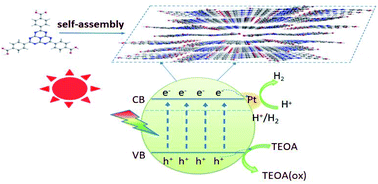Integrating active C3N4 moieties in hydrogen-bonded organic frameworks for efficient photocatalysis†
Abstract
Hydrogen-bonded organic frameworks (HOFs) provide a platform to self-assemble numerous functional species into an ordered structure. Herein, a well-known photoactive C3N4 moiety was integrated into an HOF structure (PFC-42) with the merits of high porosity and crystallinity. Under visible-light irradiation, the Pt nanoparticle-loaded PFC-42 (PFC-42-Pt) continuously produces hydrogen from water in the presence of scavengers with the evolution rate of 11.32 mmol g−1, which is outstanding among all the reported Pt/porous composite materials. The significantly high H2 evolution of PFC-42-Pt compared with that of amorphous analogue bulk C3N4–Pt and nanosheet C3N4–Pt demonstrates that the ordered arrangement of photosensitizers dramatically improves the photocatalytic activity of the material, which is further proved by the recrystallization experiment. This study represents the first example of HOF capable of photocatalysis, not only demonstrating the great application potentials of HOF in heterogeneous photocatalysis but also rendering an excellent opportunity to reveal structure–activity relations.



 Please wait while we load your content...
Please wait while we load your content...